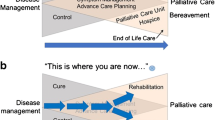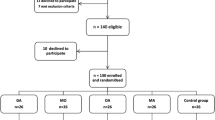Abstract
Study aim
The aim of this study was to assess the effectiveness of aetiology-based guidelines for the management of nausea and vomiting (N&V) in patients with advanced cancer.
Patients and methods
This was a prospective study of 121 patients admitted to a hospice. Patients with N&V underwent assessments at presentation, 48 h and 1 week, to determine the aetiology of N&V and the response to treatment. Antiemetics were prescribed according to aetiology-based guidelines.
Results
Sixty-one patients (50%) had N&V during their admission: 21 (17%) had isolated nausea, 2 (2%) had isolated vomiting and 38 (31%) had combined N&V. During the assessment period, physicians altered their opinion about the primary cause of N&V in 26% of cases and finally expressed confidence about the aetiology in 75% of patients. The most common cause of N&V was impaired gastric emptying (contributing in 44% of patients), followed by chemical causes (33%) and bowel obstruction (19%). At 1 week, nausea was controlled in 56% of patients, and vomiting in 89% of patients, and residual symptoms were generally mild.
Conclusions
An approach using aetiology-based guidelines in the management of N&V is moderately effective, although there are some patients with N&V refractory to standard antiemetic regimens.
Similar content being viewed by others
References
Bentley A, Boyd K (2001) Use of clinical pictures in the management of nausea and vomiting: a prospective audit. Palliat Med 15:247–253
Bruera E, Sweeney C (2002) Chronic nausea and vomiting. In: Berger AM, Portenoy RK, Weissman DE (eds) Principles and practice of palliative care and supportive oncology, 2nd edn. Lippincott Williams & Wilkins, Philadelphia, pp 222–232
Cherny N, Ripamonti C, Pereira J, Davis C, Fallon M, McQuay H, Mercadante S, Pasternak G, Ventafridda V, Expert Working Group of the European Association of Palliative Care Network (2001) Strategies to manage the adverse effects of oral morphine: an evidence-based report. J Clin Oncol 19:2542–2554
Dunlop GM (1989) A study of the relative frequency and importance of gastrointestinal symptoms, and weakness in patients with far advanced cancer. Palliat Med 4:37–43
Glare P, Pereira G, Kristjanson LJ, Stockler M, Tattersall M (2004) Systematic review of the efficacy of antiemetics in the treatment of nausea in patients with far-advanced cancer. Support Care Cancer 12:432–440
Jordhoy MS, Kaasa S, Fayers P, Ovreness T, Underland G, Ahlner-Elmqvist M (1999) Challenges in palliative care research; recruitment, attrition and compliance: experience from a randomized controlled trial. Palliat Med 13:299–310
Lichter I (1993) Results of antiemetic management in terminal illness. J Palliat Care 9:19–21
Loprinzi CL, Michalak JC, Schaid DJ, Mailliard JA, Athmann LM, Goldberg RM, Tschetter LK, Hatfield AK, Morton RF (1993) Phase III evaluation of four doses of megestrol acetate as therapy for patients with cancer anorexia and/or cachexia. J Clin Oncol 11:762–767
Mannix KA (1998) Palliation of nausea and vomiting. In: Doyle D, Hanks GWC, MacDonald N (eds) Oxford textbook of palliative medicine, 2nd edn. Oxford University Press, Oxford, pp 489–499
Miller AD, Rowley HA, Roberts TP, Kucharczyk J (1996) Human cortical activity during vestibular and drug-induced nausea detected using M.S.I. In: Highstein SM, Cohen B, Buttner-Ennever JA (eds) New directions in vestibular research. New York Academy of Sciences, New York, pp 670–672
Twycross R, Back I (1998) Nausea and vomiting in advanced cancer. Eur J Palliat Care 5:39–45
Twycross RG, Lack SA (1986) Nausea and vomiting. In: control of alimentary symptoms in far advanced cancer. Churchill Livingstone, Edinburgh, pp 117–165
Acknowledgements
We should like to thank the medical and nursing staff at St. Luke’s Hospice for their support and participation in the data collection. We should also like to thank Professor Geoff Hanks for his comments on the study design/study protocol.
Author information
Authors and Affiliations
Corresponding author
Rights and permissions
About this article
Cite this article
Stephenson, J., Davies, A. An assessment of aetiology-based guidelines for the management of nausea and vomiting in patients with advanced cancer. Support Care Cancer 14, 348–353 (2006). https://doi.org/10.1007/s00520-005-0897-1
Received:
Accepted:
Published:
Issue Date:
DOI: https://doi.org/10.1007/s00520-005-0897-1




